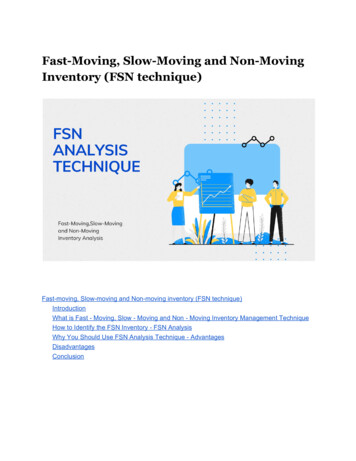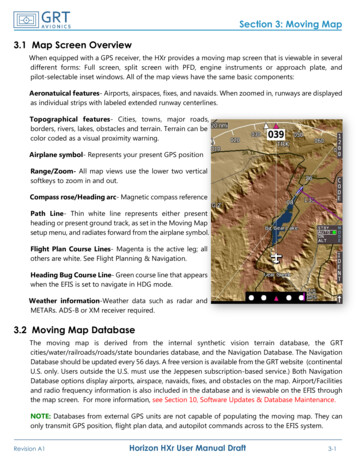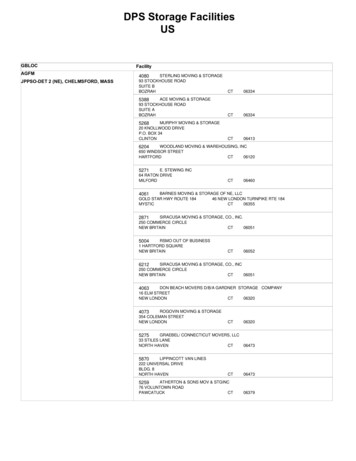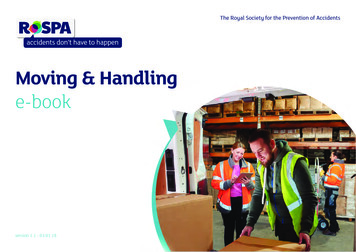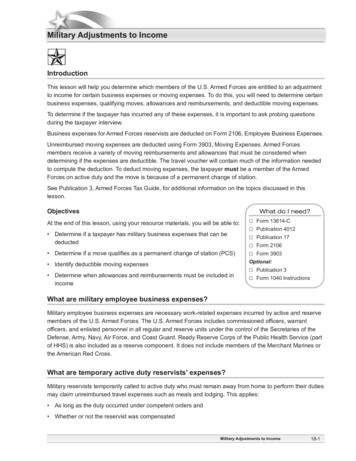
Transcription
In depthA look at current financial reporting issuesinform.pwc.comIFRS 9: Expected credit lossesAugust 2014INT2014-06At a glanceAt a glance1Background1Overview of the model2The model in detail4Transition16Implementation challenges17Appendix – Illustrativeexamples18On 24 July 2014 the IASB published the complete version of IFRS 9, ‘Financialinstruments’, which replaces most of the guidance in IAS 39. This includes amendedguidance for the classification and measurement of financial assets by introducing a fairvalue through other comprehensive income category for certain debt instruments. It alsocontains a new impairment model which will result in earlier recognition of losses.No changes were introduced for the classification and measurement of financialliabilities, except for the recognition of changes in own credit risk in othercomprehensive income for liabilities designated at fair value through profit or loss. Italso includes the new hedging guidance that was issued in November 2013. Thesechanges are likely to have a significant impact on entities that have significant financialassets and in particular financial institutions. IFRS 9 will be effective for annual periodsbeginning on or after 1 January 2018, subject to endorsement in certain territories.This publication considers the new impairment model. Further details on the changes toclassification and measurement of financial assets are included in our In Depth “IFRS 9:Classification and measurement”. The general hedging model is covered in the “Generalhedge accounting Practical guide”.BackgroundDuring the financial crisis, the G20 tasked global accounting standard setters to worktowards the objective of creating a single set of high-quality global standards. In responseto this request, the IASB and FASB began to work together on the development of newfinancial instruments standards. The IASB decided to accelerate its project to replace IAS39, and sub-divided it into three main phases: classification and measurement;impairment; and hedging. Macro hedging1 is being considered as a separate project.The Discussion Paper on Accounting for Dynamic Risk Management: a Portfolio Revaluation Approach toMacro Hedging was issued in April 2014.1IFRS 9: Expected credit lossesPwC 1
In depthTimeline– IFRS9Timeline– IFRS9No v 2 012No v 2 009C lassification andMeasurem ent( C &M) ofFinancial Assets2009Jan 2 011ED on C &MNo v 2 013Supplem entaryDocum ent onI m pairm entLim itedAm endm entsto I FRS 9I FRS 9 on HedgeAccounting20102011201220132014No v 2 009Oct 2 010March 2 013July 2 014ED onI m pairm entC &M of FinancialLiabilities andDerecognitionED FinancialI nstrum ents:I FRS 9 FinalStandardJan 2 018I FRS 9 Effective Date2015201620172018Expected C reditLossesAt the beginning of the project the FASB and IASB worked jointly on both theclassification and measurement and the impairment projects. However, due to lack ofsupport for a three-stage approach for the recognition of impairment losses in the US,the FASB developed a single measurement model, while the IASB decided to continuewith the three-stage model. In addition, the FASB decided it would not continue topursue a classification and measurement model similar to the IASB. As a consequence,IFRS 9 is not a converged standard.Overview of the modelAs stated above, the new standard outlines a ‘three-stage’ model (‘general model’) forimpairment based on changes in credit quality since initial recognition:Change in credit quality since initial recognitionRecognition of expected credit losses12-month expected creditlossesLifetime expected creditlossesLifetime expected creditlossesInterest revenueEffective interest on grosscarrying amountEffective interest on grosscarrying amountEffective interest on amortisedcost carrying amount(that is, net of credit allowance)Stage 1Stage 2Stage 3Performing(Initial recognition*)Underperforming(Assets with significantincrease in credit risk sinceinitial recognition* )Non-performing(Credit-impaired assets)(*) There is specific guidance on purchased or originated credit-impaired financial assets (see ‘Scope exceptionfrom the general model: purchased or originated credit-impaired assets below).Stage 1 includes financial instruments that have not had a significant increase in creditrisk since initial recognition or that have low credit risk at the reporting date. For theseassets, 12-month expected credit losses (‘ECL’) are recognised and interest revenue iscalculated on the gross carrying amount of the asset (that is, without deduction for creditallowance). 12-month ECL are the expected credit losses that result from default eventsthat are possible within 12 months after the reporting date. It is not the expected cashIFRS 9: Expected credit lossesPwC 2
In depthshortfalls over the 12-month period but the entire credit loss on an asset weighted by theprobability that the loss will occur in the next 12 months.Stage 2 includes financial instruments that have had a significant increase in credit risksince initial recognition (unless they have low credit risk at the reporting date) but thatdo not have objective evidence of impairment. For these assets, lifetime ECL arerecognised, but interest revenue is still calculated on the gross carrying amount of theasset. Lifetime ECL are the expected credit losses that result from all possible defaultevents over the expected life of the financial instrument. Expected credit losses are theweighted average credit losses with the probability of default (‘PD’) as the weight.Stage 3 includes financial assets that have objective evidence of impairment at thereporting date. For these assets, lifetime ECL are recognised and interest revenue iscalculated on the net carrying amount (that is, net of credit allowance).The standard requires management, when determining whether the credit risk on afinancial instrument has increased significantly, to consider reasonable and supportableinformation available, in order to compare the risk of a default occurring at the reportingdate with the risk of a default occurring at initial recognition of the financial instrument.PwC observationThe ECL model relies on a relative assessment of credit risk. This means that a loanwith the same characteristics could be included in Stage 1 for one entity and in Stage 2for another, depending on the credit risk at initial recognition of the loan for eachentity.Moreover, an entity could have different loans with the same counterparty that areincluded in different stages of the model, depending on the credit risk that each loanhad at origination.An entity should apply a definition of default that is consistent with the definition usedfor internal credit risk management purposes for the relevant financial instrument, and itshould consider qualitative factors (for example, financial covenants), where appropriate.However, there is a rebuttable presumption that default does not occur later than when afinancial asset is 90 days past due, unless an entity has reasonable and supportableinformation to demonstrate that a more lagging default criterion is more appropriate.PwC observationThe ‘90 days past due’ rebuttable presumption is supposed to serve as a backstop forthose cases where no additional information can be obtained. The purpose of therebuttable presumption is not to delay the default event until the financial assetbecomes 90 days past due, but to ensure that entities will not define default later thanthat point without reasonable and supportable information.PwC observationThe new standard will apply to a wide range of entities, as its scope is not industryspecific. While non-financial institutions will have a practical expedient (as explained inthe following pages) that will significantly reduce the amount of work needed forimplementation, entities in the financial sector will not benefit from this expedient. Allentities need to make an assessment of the implications of the new standard.It is expected that new requirements will involve modifying not only accounting policiesbut also credit management systems.IFRS 9: Expected credit lossesPwC 3
In depthAn implementation group is being established by the IASB in order to deal with themost challenging aspects of implementation.The model in detailScopeThe new model should be applied to: investments in debt instruments measured at amortised cost; investments in debt instruments measured at fair value through othercomprehensive income (FVOCI); all loan commitments not measured at fair value through profit or loss; financial guarantee contracts to which IFRS 9 is applied and that are notaccounted for at fair value through profit or loss; and lease receivables that are within the scope of IAS 17, Leases, and trade receivablesor contract assets within the scope of IFRS 15 that give rise to an unconditionalright to consideration2.PwC observationThe standard has removed the distinction that existed between loan commitments in thescope of IFRS 9 and those in the scope of IAS 37. An issuer of loan commitments shouldapply the impairment requirements of IFRS 9 to loan commitments that are nototherwise within the scope of the standard.Setting the scene: the ECL modelThe illustration below shows the overall ECL model; each decision box will be consideredover the following pages:2Entities applying IFRS 9 before adopting IFRS 15 should apply the impairment requirements to constructioncontracts under IAS 11 and IAS 18.IFRS 9: Expected credit lossesPwC 4
In depthYes(1) Is the financialinstrument a tradereceivable, contract assetor a lease receivable?NoDoes the trade receivableNo or contract asset contain asignificant financingcomponent or is it a leasereceivable?YesPolicy choice: recogniselifetime ECL or assesssignificant increase incredit risk over the life ofthe instrument(2) Is the financialinstrument a purchasedor originated creditimpaired financial asset?YesCalculate a creditadjusted effective interestrate and always recognisea loss allowance forchanges in lifetime ECLNo(3) Does the financialinstrument have a lowcredit risk at reportingdate?Yes(option(5) Recognise 12-monthto)ECL and calculate interestrevenue on gross carryingamountNoRecognise lifetime ECL(4) Has there been asignificant increase incredit risk since initialrecognition?YesNoCredit-impaired financialassets: calculate intereston carrying value net ofloss allowance(6) Recognise lifetimeECLNon credit-impairedfinancial assets: calculateinterest on gross carryingvalue(1) Is the financial instrumenta trade receivable, contractasset or a lease receivable?Scope exception from the general model: simplified approach for trade andlease receivablesThe model includes some operational simplifications for trade receivables, contract assetsand lease receivables, because they are often held by entities that do not have sophisticatedcredit risk management systems. These simplifications eliminate the need to calculate 12month ECL and to assess when a significant increase in credit risk has occurred.For trade receivables or contract assets that do not contain a significant financingcomponent, the loss allowance should be measured at initial recognition and throughoutthe life of the receivable at an amount equal to lifetime ECL. As a practical expedient, aprovision matrix may be used to estimate ECL for these financial instruments. Seeexample 1 in the Appendix for reference.IFRS 9: Expected credit lossesPwC 5
In depthTrade receivablesor contract assetsthat do not containa LLifetimeexpected creditlossesFor trade receivables or contract assets which contain a significant financing componentin accordance with IFRS 15 and lease receivables, an entity has an accounting policychoice: either it can apply the simplified approach (that is, to measure the loss allowanceat an amount equal to lifetime ECL at initial recognition and throughout its life), or it canapply the general model.Trade receivablesor contract assetsthat contain asignificant financingcomponent lease redit lossesECLMonitorsignificantincreases incredit riskPolicychoiceThe policy choice should be applied consistently, but an entity can apply the policy electionfor trade receivables, contract assets and lease receivables independently of each other.(2) Is the financialinstrument a purchased ororiginated credit-impairedfinancial asset?Scope exception from the general model: purchased or originated creditimpaired assetsThe general impairment model does not apply to purchased or originated creditimpaired assets. A financial asset is considered credit-impaired on purchase ororigination if there is evidence of impairment (as defined in IFRS 9 Appendix A) at thepoint of initial recognition (for instance, if it is acquired at a deep discount).For such assets, impairment is determined based on full lifetime ECL on initialrecognition. However, lifetime ECL are included in the estimated cash flows whencalculating the effective interest rate on initial recognition. The effective interest rate forinterest recognition throughout the life of the asset is a credit-adjusted effective interestrate. As a result, no loss allowance is recognised on initial recognition.Any subsequent changes in lifetime ECL, both positive and negative, will be recognisedimmediately in profit or loss.PwC observationThe accounting for purchased or originated credit-impaired assets is largely consistentwith how entities currently apply paragraph AG5 of IAS 39.IFRS 9: Expected credit lossesPwC 6
In depthPractical expedient for financial assets with low credit risk(3) Does the financialinstrument have a low creditrisk at reporting date?As an exception to the general model, if the credit risk of a financial instrument is low atthe reporting date, management can measure impairment using 12-month ECL, and so itdoes not have to assess whether a significant increase in credit risk has occurred. In orderfor this operational simplification to apply, the financial instrument has to meet thefollowing requirements: it has a low risk of default; the borrower is considered, in the short term, to have a strong capacity to meet itsobligations; and the lender expects, in the longer term, that adverse changes in economic andbusiness conditions might, but will not necessarily, reduce the ability of theborrower to fulfil its obligations.The credit risk of the instrument needs to be evaluated without consideration ofcollateral. This means that financial instruments are not considered to have low creditrisk simply because that risk is mitigated by collateral. Financial instruments are also notconsidered to have low credit risk simply because they have a lower risk of default thanthe entity’s other financial instruments or relative to the credit risk of the jurisdictionwithin which the entity operates.PwC observationThe use of the practical expedient is optional. That is, management can choose to applythe general model for those assets that would meet the low credit risk requirements.It is expected that this operational simplification will provide relief to entities especiallyfinancial institutions, such as insurers, who hold large portfolios of securities with highcredit ratings. This expedient will avoid having to assess whether there are significantincreases in credit risk for financial assets with low credit risk.Financial instruments are not required to be externally rated. An entity can use internalcredit ratings that are consistent with a global credit rating definition of ‘investmentgrade’.The low credit risk simplification is not meant to be a bright-line trigger for therecognition of lifetime ECL. Instead, when credit risk is no longer low, managementshould assess whether there has been a significant increase in credit risk to determinewhether lifetime ECL should be recognised. This means that just because an instrument’scredit risk has increased such that it no longer qualifies as low credit risk, it does notautomatically mean that it has to be included in Stage 2 Management needs to assess if asignificant increase in credit risk has occurred before calculating lifetime ECL for theinstrument.Exploring the general model: assessing a significant increase in credit risk(4) Has there been asignificant increase in creditrisk since initial recognition?When assessing whether the credit risk on a financial instrument has increasedsignificantly since initial recognition, management looks at the change in the risk of adefault occurring over the expected life of the financial instrument rather than thechange in the ECL. An entity should compare the risk of a default as at the reporting datewith the risk of a default occurring on the financial instrument as at the date of initialrecognition. If management chooses to make the assessment by using PD, generally alifetime PD (over the remaining life of the instrument) should be used. However, as apractical expedient, a 12-month PD can be used if it is not expected to give a differentresult to using lifetime PDs.IFRS 9: Expected credit lossesPwC 7
In depthPwC observationThere are cases where using a 12-month PD is not a reasonable approximation to usinglifetime PD. These include, for example, bullet repayment loans where the paymentobligations of the debtor are not significant during the first 12 months of the loanfacility; or loans where changes in credit-related factors only have an impact on thecredit risk of the financial instrument beyond 12 months. Example 2 in the Appendixillustrates a case where looking at 12-month PD would not be appropriate.In order to perform the assessment all information available should be taken intoaccount. When the financial instrument is collateralised, entities should assesssignificant increases in credit risk without taking into account the collateral.Nevertheless, when calculating ECL, the expected recovery from collateral should betaken into account. Example 3 in the Appendix reflects how the assessment should bedone.PwC observationThe standard allows entities to make the assessment of changes in credit risk by using a12-month PD where it would not be expected to give a different result to using lifetimePDs. This does not mean that the 12-month PD used for regulatory purposes can beused without adjustment.Twelve-month expected credit losses used for regulatory purposes are normally basedon ‘through the cycle’ (‘TTC’) probabilities of a default (that is, probability of default incycle-neutral economic conditions) and can include an adjustment for prudence. PDused for IFRS 9 should be ‘point in time’ (’PiT’) probabilities (that is, probability ofdefault in current economic conditions) and do not contain adjustment for prudence.However, regulatory PDs might be a good starting point, provided they can bereconciled to IFRS 9 PDs.Under IFRS 9, estimates of PD will change as an entity moves through the economiccycle. Under many regulatory models, as PD is calculated through the cycle, estimatesare less sensitive to changes in economic conditions. Therefore, regulatory PDs reflectlonger-term trends in PD behaviour as opposed to PiT PDs.As a consequence, during a benign credit environment, IFRS 9 PD (PiT) will be lower thanregulatory PD (TTC), while the adjustment will be the opposite during a financial crisis:The standard does not provide any guidance on how to adjust TTC PD to PiT PD. Theprocess is complex and will require the use of judgement.IFRS 9: Expected credit lossesPwC 8
In depthPwC observationManagement should be aware that a simple or absolute comparison of PDs at initialrecognition and at the reporting date is not appropriate. All other things stayingconstant, the PD of a financial instrument should reduce with the passage of time. So,management needs to consider the relative maturities of a financial instrument atinception and at the reporting date when comparing PDs. This means that the PD forthe remaining life of a financial asset at the reporting date (for example, two years ifthree years have already passed on a five-year instrument) should be compared to thePD expected at initial recognition for the last two years of its maturity (that is, foryears 4 and 5). Management might find this requirement operationally challenging.Default Rate5.00%4.50%4.00%3.50%3.00%2.50%Default 025When determining whether the credit risk on an instrument has increased significantly,management should consider reasonable and supportable best information availablewithout undue cost or effort. This information should include actual and expectedchanges in external market indicators, internal factors and borrower-specificinformation.Examples of ways in which the assessment of significant increases in credit risk could beimplemented more simply include: Establishing the initial maximum credit risk for a particular portfolio by product typeand/or region (the ‘origination credit risk’) and comparing that to the credit risk atthe reporting date. This would only be possible for portfolios of financial instrumentswith similar credit risk on initial recognition; Assessing increases in credit risk through a counterparty assessment, as long as suchassessment achieves the objectives of the proposed model; and An actual or expected significant change in the financial instrument’s externalcredit rating.The examples above are not exhaustive, so other ways of assessing a significant increasein credit risk might be used. Refer to Example 3 in the Appendix for an example onassessing increases in credit risk based on PD.Generally a financial instrument would have a significant increase in credit risk beforethere is objective evidence of impairment or before a default occurs. The standardrequires both forward-looking and historical information to be used in order todetermine whether a significant increase in credit risk has occurred.Lifetime ECL are expected to be recognised before a financial asset becomes delinquent.If forward-looking information is reasonably available, an entity cannot rely solely onIFRS 9: Expected credit lossesPwC 9
In depthdelinquency information when determining whether credit risk has increasedsignificantly since initial recognition; it also needs to consider the forward-lookinginformation. However, if information that is more forward-looking than past due statusis not available, there is a rebuttable presumption that credit risk has increasedsignificantly since initial recognition no later than when contractual payments are morethan 30 days past due.This presumption can be rebutted if there is reasonable and supportable evidence that,regardless of the past-due status, there has been no significant increase in the credit risk:For example, where non-payment is an administrative oversight, instead of resultingfrom financial difficulty of the borrower. Another example is where management hasaccess to historical evidence that demonstrates that there is no correlation betweensignificant increases in the risk of a default occurring and financial assets on whichpayments are more than 30 days past due, but that evidence does identify such acorrelation when payments are more than 60 days past due.Generally, a significant increase in credit risk happens gradually over time and before thefinancial asset becomes credit-impaired or is in default. As a result, the lifetime ECLshould not be delayed and is recognised before a financial asset is regarded as creditimpaired or in default.Level at which the increase in credit risk assessment should be performed(4) Has there been asignificant increase in creditrisk since initial recognition?The model can be applied at an individual or portfolio level. However, some factors orindicators may not be identifiable at an instrument level. In such cases, the factors orindicators should be assessed at a portfolio level. Management cannot avoid calculatinglifetime ECL by considering the assessment at an individual asset level only, ifinformation available at portfolio level indicates that there has been an increase in creditrisk for the instruments included in the portfolio.Depending on the nature of the financial instrument and the credit risk informationavailable for particular groups of financial instruments, management might not be ableto identify significant changes in credit risk for individual financial instruments beforethe financial instrument becomes past due. This might be the case for financialinstruments such as retail loans for which there is little or no updated credit riskinformation that is routinely obtained and monitored on an individual instrument basisuntil a customer breaches the contractual terms.If changes in the credit risk for individual financial instruments are not captured beforethey become past due, a loss allowance based only on credit information at an individualfinancial instrument level would not faithfully represent the changes in credit risk sinceinitial recognition.In some circumstances management does not have reasonable and supportableinformation that is available without undue cost or effort to measure lifetime ECL on anindividual instrument basis. In that case, lifetime ECL should be recognised on acollective basis that considers comprehensive credit risk information. Thiscomprehensive credit risk information must incorporate not only past-due informationbut also all relevant credit information, including forward-looking macro-economicinformation, in order to approximate the result of recognising lifetime ECL when therehas been a significant increase in credit risk since initial recognition on an individualinstrument level.Management can group financial instruments on the basis of shared credit riskcharacteristics with the objective of facilitating an analysis that is designed to enablesignificant increases in credit risk to be identified on a timely basis. The entity should notIFRS 9: Expected credit lossesPwC 10
In depthobscure this information by grouping financial instruments with different risk characteristics.Examples of shared credit risk characteristics might include, but are not limited to:a. the instrument type;b. the credit risk ratings;c. the collateral type;d. the date of origination;e. the remaining term to maturity;f.the industry;g. the geographical location of the borrower; andh. the value of collateral relative to the commitment if it has an impact on theprobability of a default occurring (for example, non-recourse loans in somejurisdictions or loan-to-value ratios).PwC observationIFRS 9 provides some examples of how to perform the portfolio analysis. It establishesthat individual exposures could be grouped into sub-portfolios on the basis of commonborrower-specific characteristics, such as geographical location or postcodes,headroom/access affordability at origination or behavioural scoring (that is, ‘bottomup’ approach). Alternatively management could estimate the proportion of the portfoliothat has experienced a significant increase in credit risk using general information andcalculate expected credit losses on that basis (that is, ‘top down’ approach). Example 4in the Appendix illustrates these approaches.If management does not have forward-looking information available at an individuallevel, and therefore assesses significant increases in credit risk using past-dueinformation only (‘bottom up’ approach), the standard requires management to alsoconsider forward-looking information at a portfolio level in order to determine whetherthere has been a significant increase in credit risk (‘top down’ approach).Measuring ECL(5) Recognise 12-month ECLand calculate interestrevenue on gross carryingamount(6) Recognise lifetime ECLECL are a probability-weighted estimate of credit losses. A credit loss is the differencebetween the cash flows that are due to an entity in accordance with the contract and thecash flows that the entity expects to receive discounted at the original effective interestrate. Because ECL consider the amount and timing of payments, a credit loss arises evenif the entity expects to be paid in full but later than when contractually due.The illustration below shows the ECL for a financial asset and a loan commitment:Financial assetsECL represent a probability-weighted estimate of the difference over the remaining life ofthe financial instrument, between:Pr esent value ofcon tractual cash flowsIFRS 9: Expected credit losses Pr esent value of cashflows the entity expectst o r eceivePwC 11
In depthUndrawn loan commitmentsECL represent a probability-weighted estimate of the difference over the remaining life ofthe financial instrument, between:Pr esent value ofcon tractual cash flows ifh older draws down Pr esent value of cashflows the entity expectst o r eceive if drawn downThe time value of money must be taken into account when calculating the ECL(regardless of whether it is the 12-month or the lifetime ECL). Management shoulddiscount the cash flows that it expects to receive at the effective interest rate determinedat initial recognition, or an approximation thereof in order to calculate ECL. If a financialinstrument has a variable interest rate, ECL should be discounted using the currenteffective interest rate.When calculating ECL on financial assets classified in the FVOCI category, movements inthe ECL provision will impact profit or loss (‘P&L’). Under the model, impairmentcharges in P&L will always occur earlier as compared to current IAS 39 guidance, andthis is no different for financial assets classified in the FVOCI category. Example 5 in theAppendix illustrates the estimation of credit losses for FVOCI financial assets.An estimate of ECL on loan commitments should be consistent with expectations ofdraw-downs on that loan commitment. That is, management should consider theexpected portion of the loan commitment that will be drawn down within 12 mont
Financial A ssets Nov 2013 IFRS 9 on Hedge Accounting Jan 2018 IFRS 9 E ffective Date Nov 2012 ED on C&M Limited Amendments to IFRS 9 Oct 2010 C&M of Financial Liabilities and Derecognition July 2014 IFRS 9 Final Standard March 2013 ED Financial Instruments: Expected Credit Losses Nov 2009 ED on Impairment Jan 2011 Supplementary Document on

